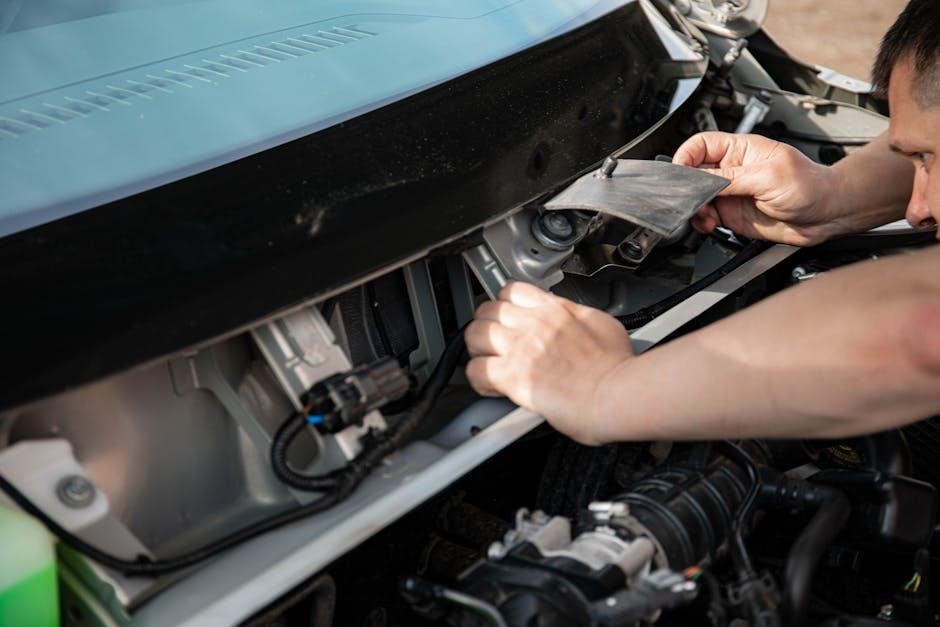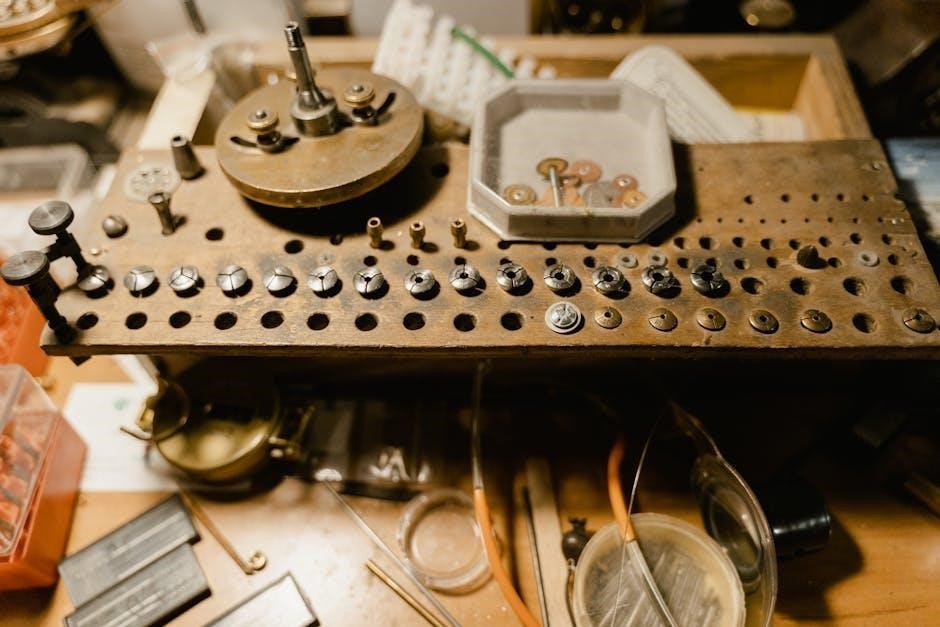Mikuni carburetors are renowned for their precision and reliability, offering superior fuel delivery in various engines. Their popularity stems from versatility and ease of tuning for optimal performance.
1.1 Overview of Mikuni Carburetors
Mikuni carburetors are highly regarded for their performance, durability, and adaptability across various engines. Known for their precise fuel delivery, they are widely used in motorcycles, ATVs, and racing applications. The design incorporates components like idle circuits, main jets, and needles, ensuring efficient air/fuel mixture control. Popular models include the HSR42-45 and TM series, each tailored for specific engine needs. Their versatility allows for fine-tuning, making them a favorite among enthusiasts and professionals seeking optimal engine performance.
1.2 Importance of Proper Tuning
Proper tuning of Mikuni carburetors is essential for achieving optimal engine performance, fuel efficiency, and reliability; Incorrect tuning can lead to poor idle, reduced power, or even engine damage. Tuning ensures the correct air/fuel mixture is delivered at all RPM levels, preventing lean or rich conditions. It also maximizes the carburetor’s compatibility with exhaust systems and other engine modifications. Regular tuning adjustments are necessary to adapt to changes in engine setup, environmental conditions, or wear and tear on components.

Understanding Carburetor Components
Mikuni carburetors consist of essential components like the float bowl, jets, and needle, each playing a critical role in fuel delivery and airflow regulation for optimal performance.
2.1 Main Components of Mikuni Carbs
Mikuni carburetors feature essential components like the float bowl, jets, and needle. The float bowl stores fuel, while jets regulate fuel flow at different RPMs. The needle adjusts the fuel-air mixture based on throttle position. Other critical parts include the idle circuit, throttle valve, and air/fuel mixture screw, each playing a vital role in ensuring proper fuel delivery and engine performance. Understanding these components is key to effective tuning and maintaining optimal engine operation.
2.2 Function of Idle Circuit (Pilot System)
The idle circuit, or pilot system, delivers fuel at low RPMs, ensuring smooth engine operation during idling and low-speed conditions. It operates independently of the main jet system, using a mixture screw to regulate the air-fuel ratio. Proper adjustment of the idle circuit is critical for eliminating rough idling, hesitation, or increased emissions. The pilot jet and air screw work together to fine-tune fuel flow, providing a stable and efficient idle. This system is essential for maintaining optimal performance at lower engine speeds.
2.3 Role of the Needle and Jetting
The needle and jetting system in Mikuni carburetors regulates fuel flow at various throttle positions. The needle controls fuel delivery between mid and high RPMs, with its position adjusted via notches to achieve the desired richness. The main jet determines fuel flow at high RPMs, directly impacting top-end power. Proper jetting ensures optimal performance, preventing lean or rich conditions. Adjustments to the needle and jets are critical for balancing power delivery, fuel efficiency, and engine reliability across the entire RPM range.

Basic Tuning Principles
Basic tuning involves understanding carb components, setting proper baseline adjustments, and using tools to optimize performance and fuel efficiency for smooth engine operation.
3.1 Initial Setup and Preparation
Initial setup involves cleaning and inspecting all carburetor components, ensuring proper installation, and syncing multiple carbs if applicable. Start with baseline settings from the manual, adjusting the idle mixture screw and float level. Always refer to the specific model’s manual for precise instructions, as variations exist between Mikuni HSR, TM, and CV carbs. Proper preparation ensures a smooth tuning process and optimal engine performance, avoiding potential issues like lean or rich conditions.
3.2 Tools and Materials Needed
Essential tools include a flathead screwdriver, Phillips screwdriver, pliers, and a jetting kit. Additional materials like a tuner’s guide, air/fuel gauge, and cleaning supplies are recommended. A mainspring compressor may be needed for certain models. Ensure all components are clean and free from debris before tuning. Proper tools and preparation are critical for achieving optimal performance and avoiding damage to the carburetor. Always refer to the specific manual for your Mikuni model to confirm required tools and materials.
3.3 Step-by-Step Tuning Process
Start by setting the idle mixture screw to 1.5–2 turns out. Adjust the idle speed screw to achieve a slow, steady idle. Warm up the engine and test throttle response. Fine-tune the idle circuit for smooth operation. Next, assess the pilot jet’s performance during low RPM transitions. If necessary, adjust or replace the pilot jet for better throttle response. Move to the main jet, testing at high RPM to ensure proper power delivery. Adjust the needle position if needed for optimal fuel flow. Finally, verify the air/fuel mixture and make any necessary fine-tuning adjustments.

Idle Circuit Tuning
The idle circuit on Mikuni carburetors is crucial for smooth low-speed engine operation. It includes the idle mixture screw, idle speed screw, and pilot jet. Adjust the idle mixture screw to achieve the correct air/fuel ratio at idle, typically between 1.5 to 2 turns out from fully closed. Fine-tune the idle speed screw to maintain a steady RPM. The pilot jet provides fuel at low RPM; if the engine hesitates during acceleration, consider replacing the pilot jet. Ensure proper float level for consistent fuel flow. Adjustments should be made in small increments, with the engine at operating temperature, to optimize performance and prevent stalling or running rich.
4.1 Adjusting the Idle Mixture Screw
Begin by setting the idle mixture screw 1.5 to 2 turns out from fully closed. Turn the screw clockwise for a leaner mixture and counterclockwise for richer. Monitor engine response; a hesitation indicates a lean condition, while a rich mixture may cause sooting. Fine-tune in small increments, ensuring smooth idle and optimal throttle response. Adjust with the engine at operating temperature and in an upright position for accurate results. Proper adjustment ensures efficient fuel delivery and prevents engine stalling or running rich.
4.2 Setting the Correct Idle Speed
Start with the idle mixture screw set at 1.5 to 2 turns out. Adjust the throttle stop screw to achieve a slow, steady idle, typically between 900-1,200 RPM. Ensure the engine is at operating temperature and the bike is upright. A correct idle speed ensures smooth operation and prevents stalling. Avoid over-revving during adjustment. Once set, recheck the idle mixture screw for optimal performance. Proper idle speed is crucial for responsive throttle response and efficient low-speed operation.
Pilot and Main Jet Tuning
Pilot and main jet tuning ensures proper air-fuel mixture delivery for optimal performance. Select the right main jet for peak power and adjust the pilot jet for smooth low-speed operation.
5.1 Selecting the Right Main Jet Size
Selecting the right main jet size is crucial for optimal high-RPM performance. It controls fuel flow when the throttle is fully open, ensuring the correct air-fuel mixture. Factors like engine modifications, exhaust, and air filters influence jet size. Start with the manufacturer’s recommendation and fine-tune through trial and error. A too-small jet causes a lean mixture, leading to overheating and power loss, while a too-large jet results in a rich mixture, reducing efficiency. Proper sizing ensures smooth operation and maximum power delivery.
5.2 Adjusting the Pilot Jet for Optimal Performance
The pilot jet regulates fuel flow at low RPM, ensuring smooth idle and throttle response. Start with the manufacturer-recommended size, then fine-tune by adjusting the mixture screw. A lean mixture (too small a jet) causes erratic idle, while a rich mixture (too large a jet) wastes fuel. Test by gradually turning the mixture screw out until the engine runs smoothly. Proper adjustment enhances low-speed performance, prevents stalling, and maintains consistent power delivery during acceleration.
Air/Fuel Mixture Adjustment
Air/fuel mixture adjustment is critical for engine performance, ensuring proper combustion efficiency. The optimal ratio varies by engine speed and load, requiring precise tuning for smooth operation and maximum power delivery.
6.1 Understanding Air/Fuel Ratios
Air/fuel ratios are the proportion of air to fuel in the combustion mixture, critical for optimal engine performance. Mikuni carbs operate within a range of 12:1 to 15:1 for most engines. A richer mixture (lower ratio) enhances power but reduces efficiency, while a leaner mixture (higher ratio) improves fuel economy but risks engine damage. Proper adjustment ensures smooth operation, maximum power, and longevity, requiring precise tuning of jets and needles to match engine demands at various RPM levels.
6.2 Fine-Tuning the Mixture for Smooth Operation
Fine-tuning the air/fuel mixture ensures smooth engine operation across all RPM ranges. Start with the idle circuit, adjusting the mixture screw for a stable idle. Then, test under load, gradually refining the main jet and needle settings to eliminate stumbling or hesitation. Proper tuning delivers consistent power delivery, prevents lean or rich conditions, and optimizes engine performance for various riding conditions.

High RPM Tuning
High RPM tuning focuses on optimizing engine performance at higher speeds. Adjusting the needle position and main jet size ensures proper fuel delivery for maximum power output.
7.1 Optimizing for Maximum Power
Optimizing for maximum power at high RPM involves precise adjustments to the main jet and needle position. The main jet size directly impacts fuel flow during high-speed operation, ensuring the engine runs smoothly without lean conditions. The needle’s position, with its five notches, fine-tunes fuel delivery between half and three-quarters throttle. Start with the recommended jet size and adjust based on performance. Trial and error, combined with careful observation of the engine’s response, is key to achieving peak power output at high RPM.
7.2 Adjusting the Needle for High RPM Performance
Adjusting the needle for high RPM performance involves selecting the correct notch position to optimize fuel delivery. Start with the needle in the middle position and test throttle response. Moving the needle up (leaner) or down (richer) affects fuel flow at higher speeds. Listen for engine performance changes, such as stumbling or smooth power delivery. Fine-tune the position based on the engine’s response, ensuring proper air/fuel mixture at peak RPM. This adjustment is critical for maximizing power and preventing lean conditions.

Float Level Adjustment
Proper float level adjustment is crucial for precise fuel delivery. Invert the carburetors, remove the float bowls, and ensure the actuator tab lightly contacts the needle valve.
8.1 Importance of Proper Float Level
Proper float level adjustment is critical for maintaining consistent fuel delivery and engine performance. Incorrect float levels can lead to poor idle quality, uneven throttle response, and reduced power output. If the float level is too high, it can cause excessive fuel flow, flooding the engine. Conversely, a low float level may result in lean conditions, potentially damaging the engine. Correct adjustment ensures optimal fuel flow, preventing these issues and maintaining smooth operation across the RPM range.
8.2 Step-by-Step Float Level Adjustment
To adjust the float level, start by inverting the carburetors and removing the float bowls. Locate the float assembly and gently bend the actuator tab until it makes light contact with the needle valve when inverted. Reinstall the float bowls and ensure the fuel level aligns with the specified mark. Finally, test the engine at idle to confirm smooth operation and proper fuel delivery. Accurate adjustment ensures consistent performance and prevents fuel-related issues.
Exhaust System Considerations
Exhaust system design significantly impacts Mikuni carburetor tuning, as certain configurations can interfere with fuel delivery and engine performance. Proper compatibility ensures optimal tuning and smooth operation.
9.1 Impact of Exhaust Design on Carb Tuning
Exhaust system design plays a crucial role in Mikuni carburetor tuning. Certain configurations can create back-pressure variations that affect engine breathing and fuel delivery. These variations alter the air-fuel mixture’s velocity in the intake tract, potentially leading to lean or rich conditions if not properly addressed. Ensuring the carburetor’s jetting and circuits are matched to the exhaust system is essential for balanced performance. Misalignment can result in issues like rough idle or reduced power at high RPM, emphasizing the need for precise tuning adjustments.
9.2 Ensuring Proper Exhaust System Compatibility
Ensuring compatibility between the exhaust system and Mikuni carburetor is crucial for optimal performance. Exhaust systems that create excessive back-pressure, such as those with restrictive baffles, can disrupt airflow and fuel delivery. This often requires adjustments to the carburetor’s jetting and tuning circuits to maintain the correct air-fuel mixture. Materials and design features of the exhaust system also play a role, as they influence heat dissipation and back-pressure dynamics. Proper compatibility ensures smooth engine operation and maximizes power output across the RPM range.
Troubleshooting Common Issues
Common issues with Mikuni carbs include rough idling, poor throttle response, and lean or rich conditions. These often stem from improper jetting, faulty float levels, or clogged circuits.
10.1 Identifying and Fixing Lean or Rich Conditions
A lean condition occurs when there’s too much air relative to fuel, causing engine overheating or poor performance. A rich condition, with too much fuel, wastes gas and fouls spark plugs. To diagnose, look for symptoms like backfiring, rough idle, or engine hesitation. Adjust the pilot or main jets to balance the air/fuel mixture. For lean conditions, enrich the mixture by increasing jet sizes. For rich conditions, reduce jet sizes or adjust the needle position to lean the mixture.
10.2 Solving Idle and Throttle Response Problems
Idle and throttle response issues often stem from improper idle mixture or float level settings. Start by adjusting the idle mixture screw to achieve a smooth idle, ensuring the engine doesn’t stall or run rough. If the throttle response feels sluggish, check the pilot jet size and ensure it’s clean. For hesitation during acceleration, inspect the needle and jetting configuration, making adjustments as needed. A clean carburetor and proper synchronization of multiple carbs are essential for optimal performance.

Maintenance and Upkeep
Maintenance is crucial for Mikuni carburetors. Regular cleaning and inspection of components ensure optimal performance. Adhere to a scheduled upkeep routine to prevent issues.
11.1 Cleaning and Inspecting Carburetor Components
Regular cleaning and inspection of Mikuni carburetors are vital for maintaining performance and preventing issues. Disconnect the fuel supply and remove components like bowls and jets. Use a carburetor cleaning solution to eliminate dirt and grime, ensuring all passages are clear. Dry all parts thoroughly before reassembly. Inspect the float assembly, needle valve, and other components for wear or damage. Replace any worn parts to ensure proper function. Regular checks help maintain fuel efficiency and engine reliability. After cleaning and inspecting, reassemble the carburetor carefully and test to ensure smooth operation.
11.2 Regular Maintenance Schedule
A regular maintenance schedule is essential to keep Mikuni carburetors functioning optimally. Clean the carburetor every 1,000 to 3,000 miles, depending on usage. Inspect fuel lines, jets, and the float assembly for wear or clogging. Replace any damaged components promptly. Adjust the idle mixture screw and float levels as needed. Ensure all connectors are tight to prevent vacuum leaks. Regular tuning and maintenance prevent performance issues and extend the carburetor’s lifespan. A well-maintained Mikuni carburetor ensures smooth engine operation and peak efficiency.

Specialized Tuning for Specific Models
Mikuni carburetors require model-specific tuning for optimal performance. Adjustments vary for HSR42-45 and TM series carbs, focusing on jetting, idle circuits, and exhaust system compatibility to maximize efficiency and power output.
12.1 Tuning Mikuni HSR42-45 Carbs
Tuning Mikuni HSR42-45 carbs involves precise adjustments to jetting, idle circuits, and needle positions. Start by selecting the correct main jet for top-end power and adjust the pilot jet for smooth throttle response. The needle’s position affects fuel flow at mid-range throttle, with five notches offering lean to rich adjustments. Ensure proper float level and idle mixture screw settings for optimal idle performance. Exhaust system design significantly impacts tuning, so compatibility is crucial for achieving smooth operation and maximum power output.
12.2 Adjusting Mikuni TM Series Carbs
The Mikuni TM Series carburetors require precise adjustments for optimal performance. Begin with installing the correct main jet and pilot jet based on engine specifications. Adjust the idle mixture screw to ensure smooth idle operation, typically starting at 1-2 turns out. Fine-tune the float level to maintain proper fuel flow and prevent starvation or flooding. Additionally, consider the exhaust system’s influence on tuning, as it can affect low-end and mid-range performance. Regular maintenance and inspection of components ensure long-term reliability and peak efficiency.

CV Carburetor Tuning
13.1 Unique Aspects of CV Carbs
CV carburetors feature a vacuum-operated slide that dynamically adjusts to throttle positions, ensuring a precise air/fuel mixture. Their design eliminates the need for multiple choke sizes, providing consistent performance across the RPM range. The slide’s movement is controlled by engine vacuum, allowing for smooth transitions and optimal fuel delivery. This unique system enables better low-end torque and high-RPM performance, making CV carbs ideal for engines requiring a wide power range. Their simplicity and adaptability make them popular for both street and racing applications.
13;2 Tuning CV Carbs for High RPM Engines
CV carbs excel in high-RPM applications due to their vacuum-operated slide design, which provides a wide, linear power delivery. For optimal high-RPM tuning, focus on selecting the correct main jet size to ensure proper fuel flow at peak revs. Adjusting the needle height or clip position fine-tunes the fuel mixture in the mid-to-high RPM range. Additionally, ensuring proper air/fuel mixture and considering high-flow air filters and exhaust systems can enhance performance at elevated engine speeds, making CV carbs highly adaptable for racing and high-performance engines.

Advanced Tuning Techniques
Advanced techniques involve precision jetting, needle adjustments, and optimizing for high-performance applications. These methods require specialized tools and expertise to maximize power and efficiency at high RPMs.
14.1 Using Advanced Jetting Combinations
Advanced jetting combinations involve precise main jet, needle, and pilot jet adjustments to optimize fuel flow for high-performance engines. Start with standard jets and fine-tune based on specific engine demands. Experimenting with richer or leaner combinations can enhance power delivery and efficiency. Always test adjustments through dyno runs or on-track performance. Proper jetting ensures smooth operation across the RPM range, balancing power output with fuel economy. Expertise and specialized tools are essential for achieving optimal results in racing or high-performance applications.
14.2 Optimizing for Racing and High Performance
For racing and high-performance applications, optimizing Mikuni carbs requires precise tuning of main jets, needle positions, and pilot jets. Start with a baseline jetting combination, then adjust based on dyno or track performance. Experiment with richer main jets for maximum power at high RPM. Fine-tune the needle clip position to smooth mid-range delivery. Ensure the pilot jet is calibrated for crisp throttle response. Regular testing and iteration are crucial to achieve peak performance while maintaining reliability and fuel efficiency at high engine speeds.
Mastery of Mikuni carb tuning requires patience, understanding, and practice. By following these principles, riders can unlock optimal performance, reliability, and efficiency from their engines. Confidence guaranteed.
15.1 Summary of Key Tuning Principles
Effective Mikuni carb tuning hinges on understanding the idle circuit, pilot, and main jet functions. Proper float levels and air/fuel mixtures ensure smooth operation. Regular maintenance, like cleaning and inspecting components, is essential. Adjustments should be methodical, starting with idle mixture screws and progressing to high RPM tuning. Patience and practice are crucial for mastering these techniques, as small changes significantly impact performance. Always refer to specific manuals for model-specific guidance to achieve optimal results.
15.2 Final Tips for Mastering Mikuni Carb Tuning
Start with basic adjustments and gradually fine-tune for optimal performance. Always use the correct tools and reference model-specific manuals. Practice patience, as small changes can significantly impact results. Regularly clean and inspect components to ensure reliability. Experiment with jetting combinations but document changes for easy reversal. Stay consistent with maintenance schedules to maintain peak efficiency. Mastery requires hands-on experience and a deep understanding of how each adjustment affects engine behavior.


